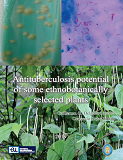Antituberculosis potential of some ethnobotanically selected plants
Fecha
2019Autor
Delgado Paredes, Guillermo Eduardo
Rojas Idrogo, Consuelo
Metadatos
Mostrar el registro completo del ítemResumen
The structure of the book includes two scopes: The scope of the taxonomic location of the plant species and the scope of the biological activity of the extracts and pure substances isolated from the plant species included in present study. On the taxonomy of plants, we noticed that our consuted references used the Cronquist classification, whish is bases on morphological characteristics and phylogenetic relationships (Cronquist, 1988). However, at present, numerous plant taxonomists have enthusiastically accepted the APG classification (Angiosperm Phylogen Group); it was proposed in several articles published over almost 20 years (APG I, 1998; APG II, 2003; APG III, 2009; APG IV, 2016) and based on molecular analysis of DNA and nucleotide sequences of key enzymes. That is why in this review, although the APG classification has been chosen, the Cronquist classification has also been included in parallel to identify the established changes and in some way relates the has also been included in parallel to identify the established changes and in some way relates the plant species to the seondary metabolities that biosynthesizing, remembering that some researchers proposed chemotaxonomy at some point (Gottlieb, 1982).
Colecciones
- Libros [25]
El ítem tiene asociados los siguientes ficheros de licencia:








